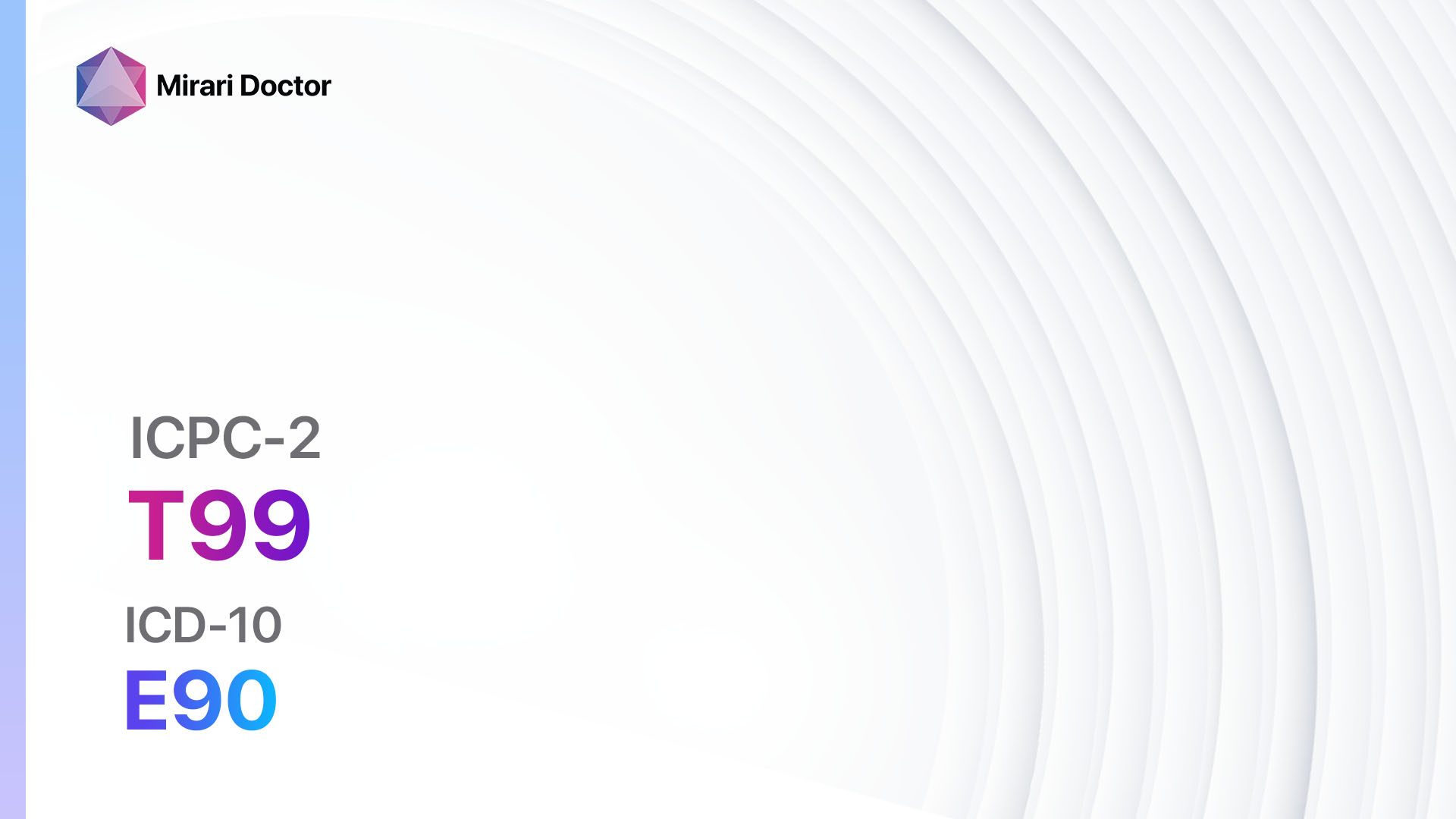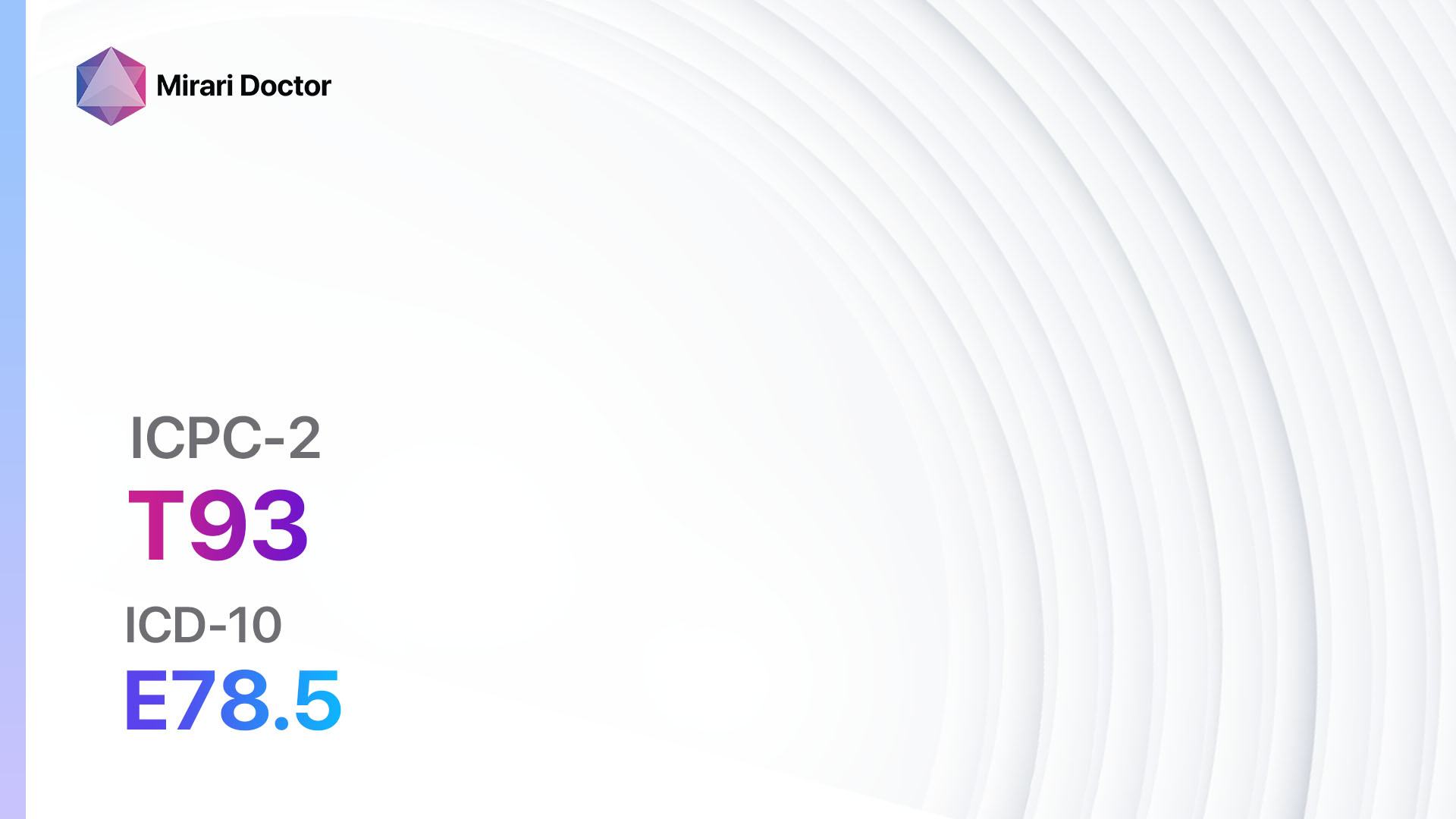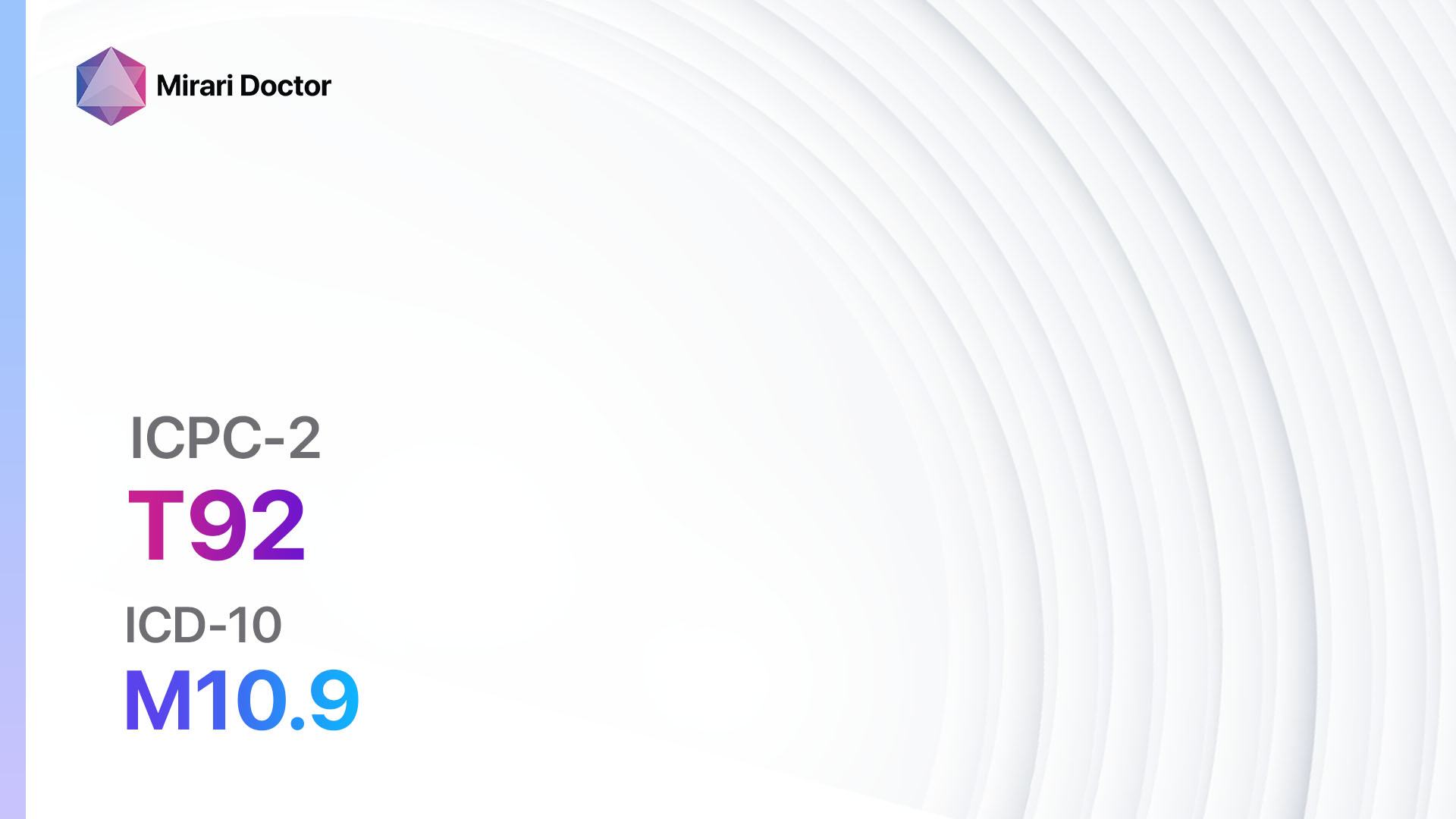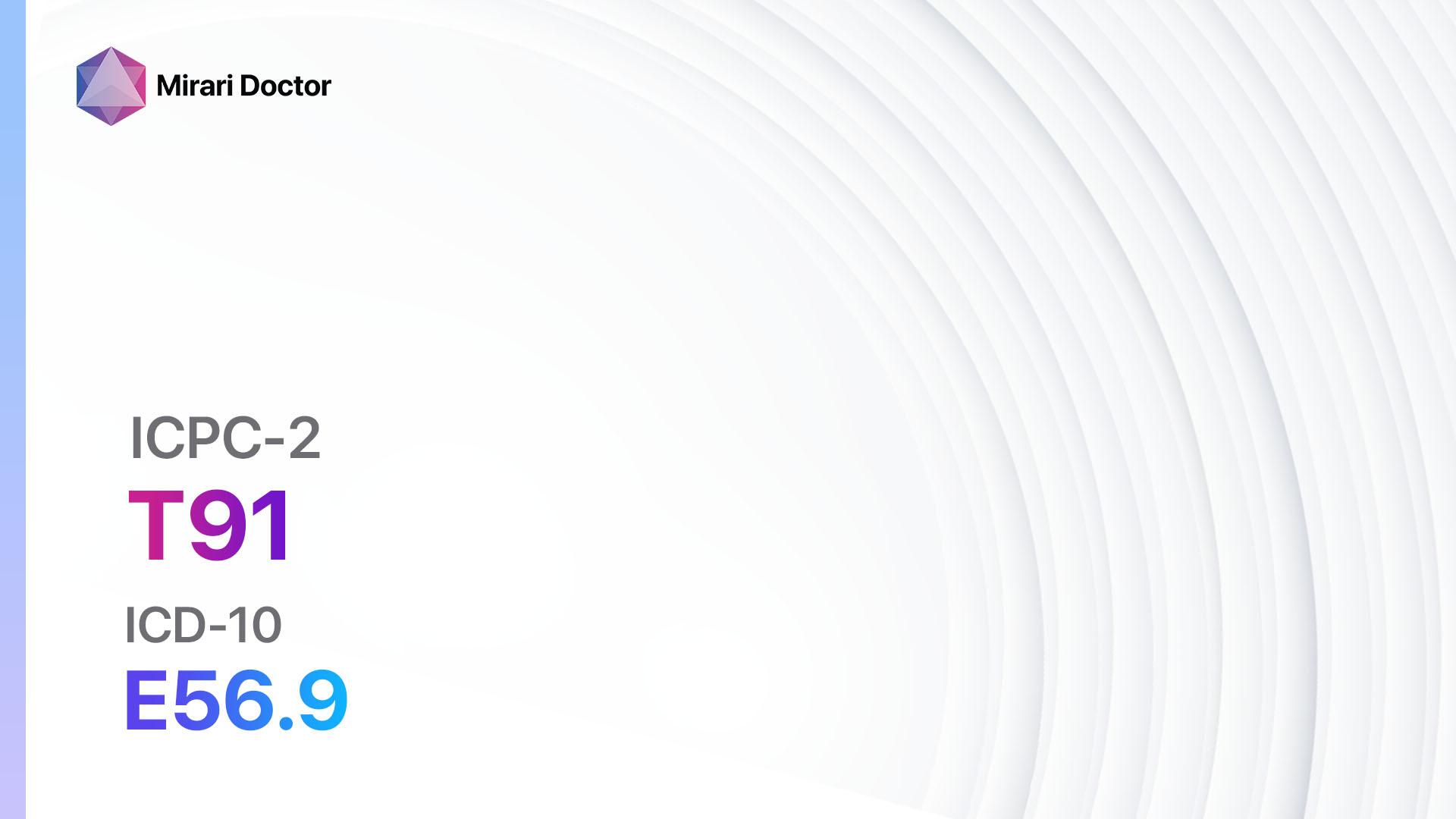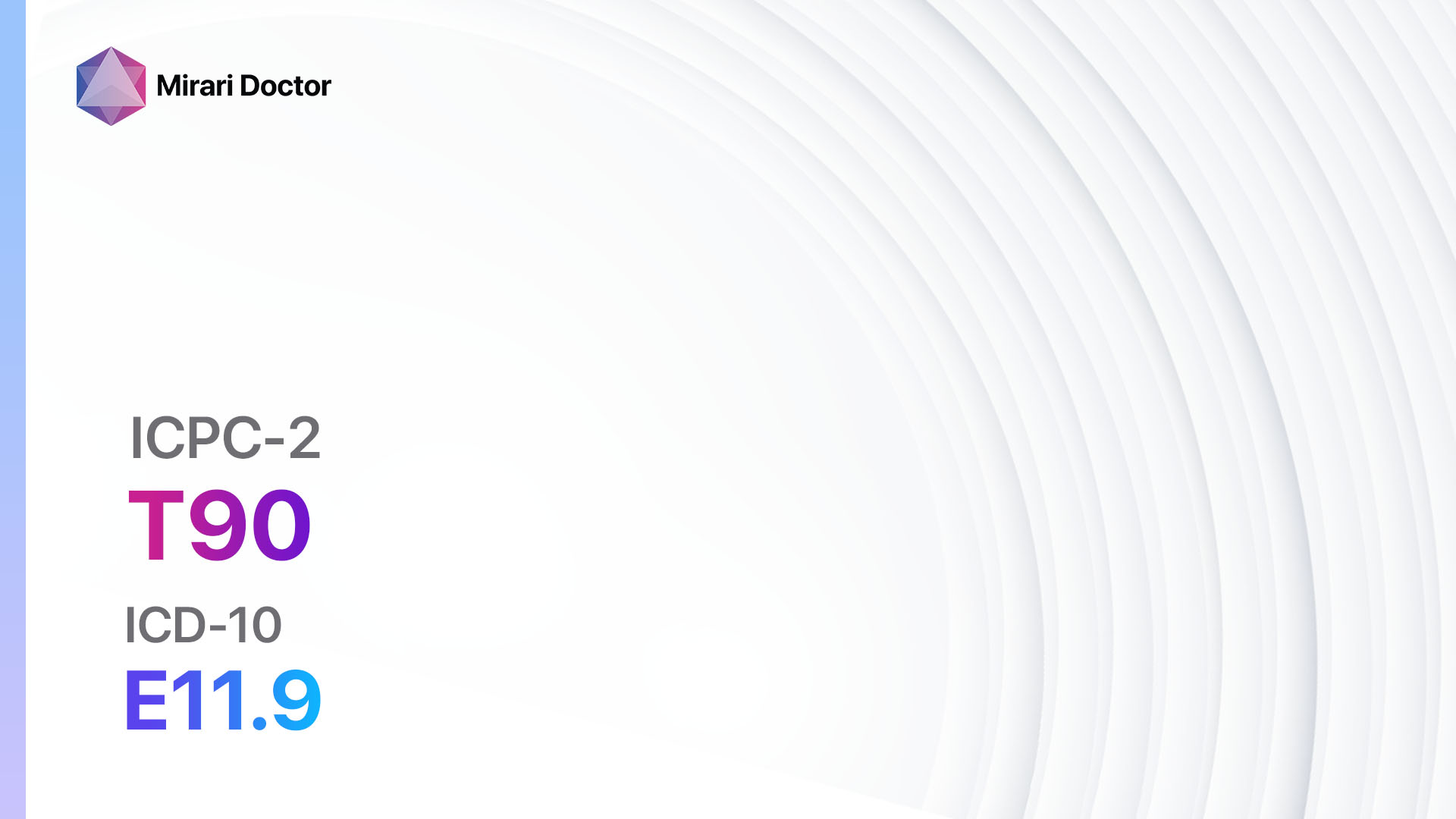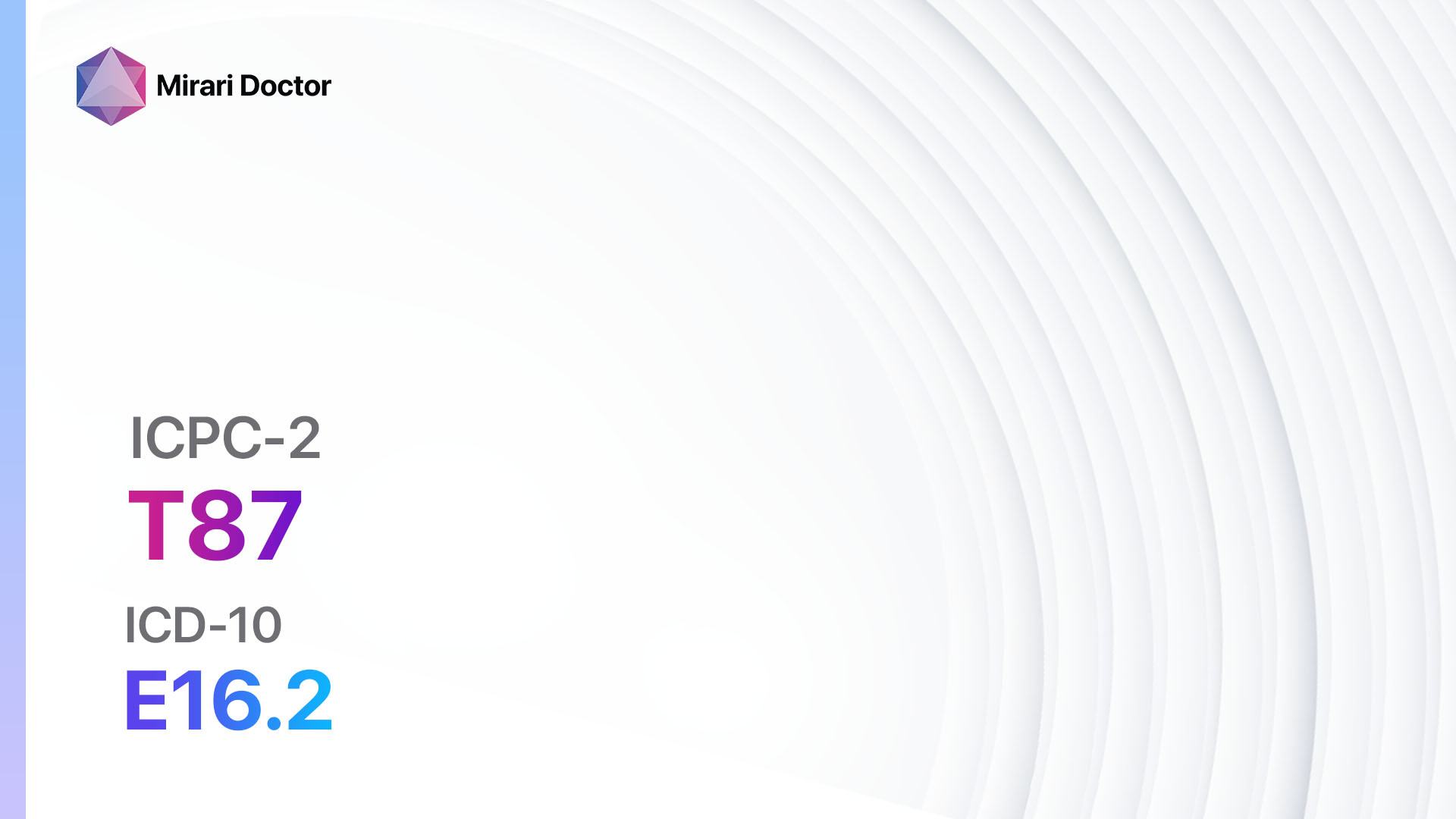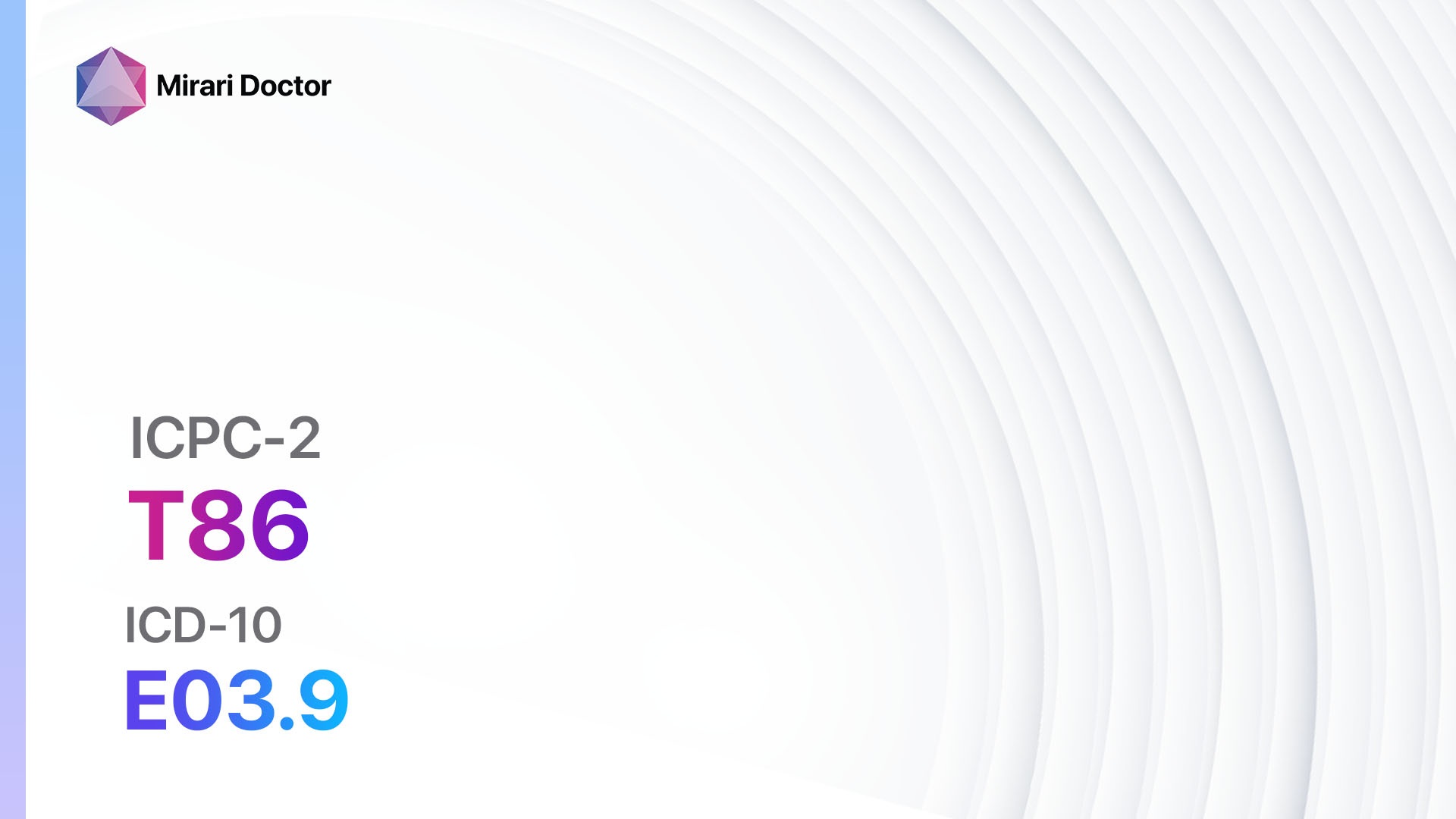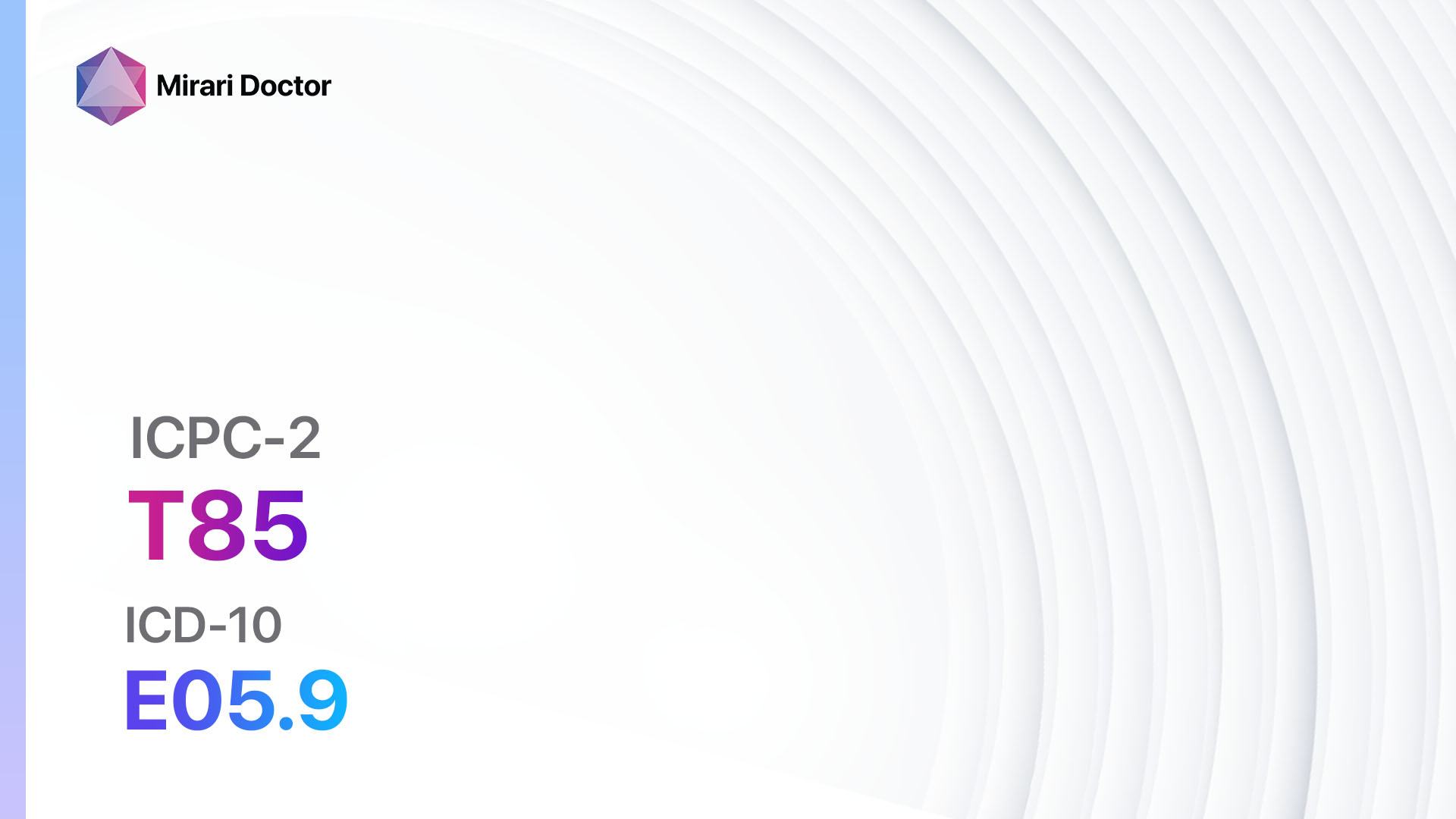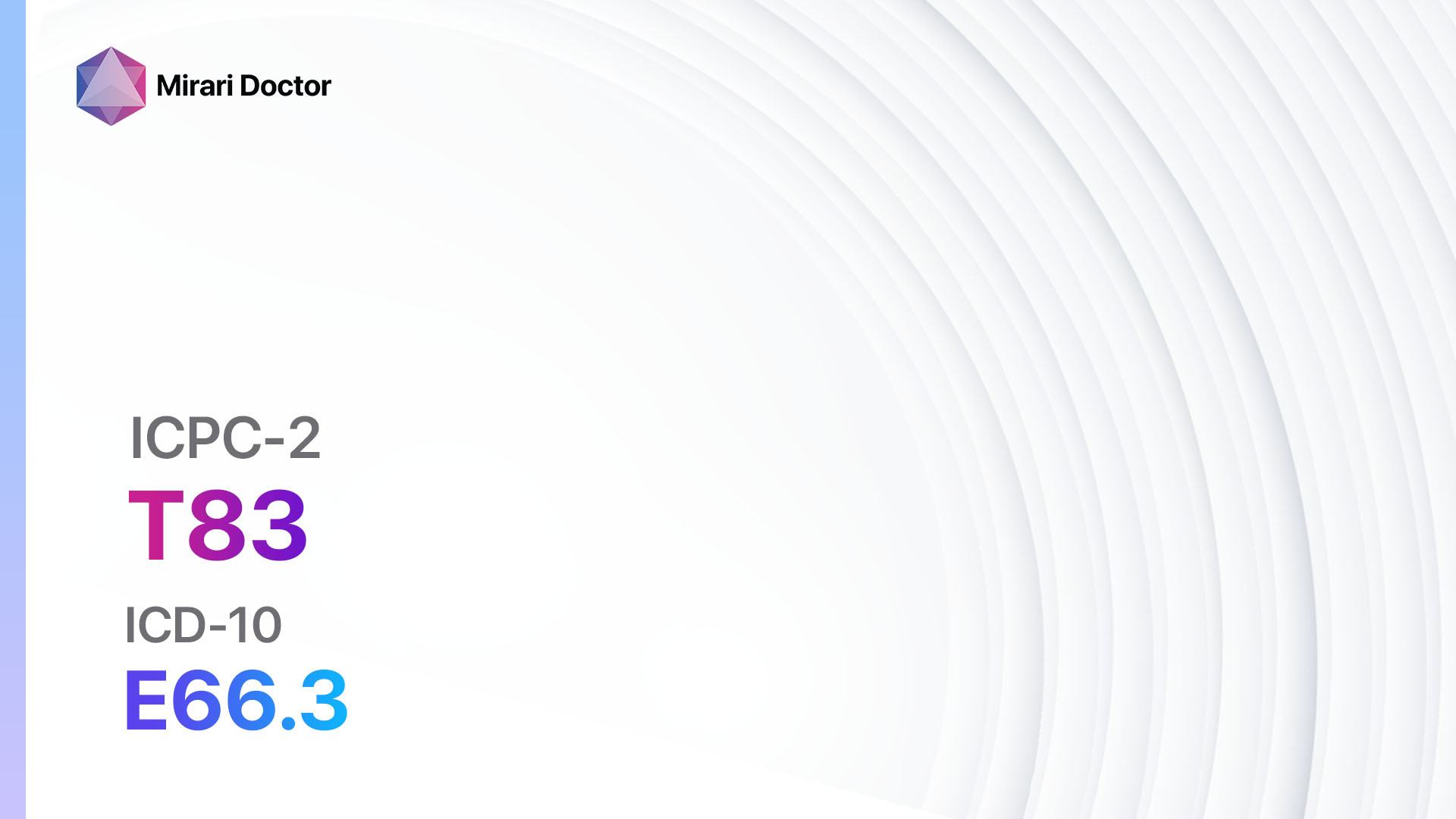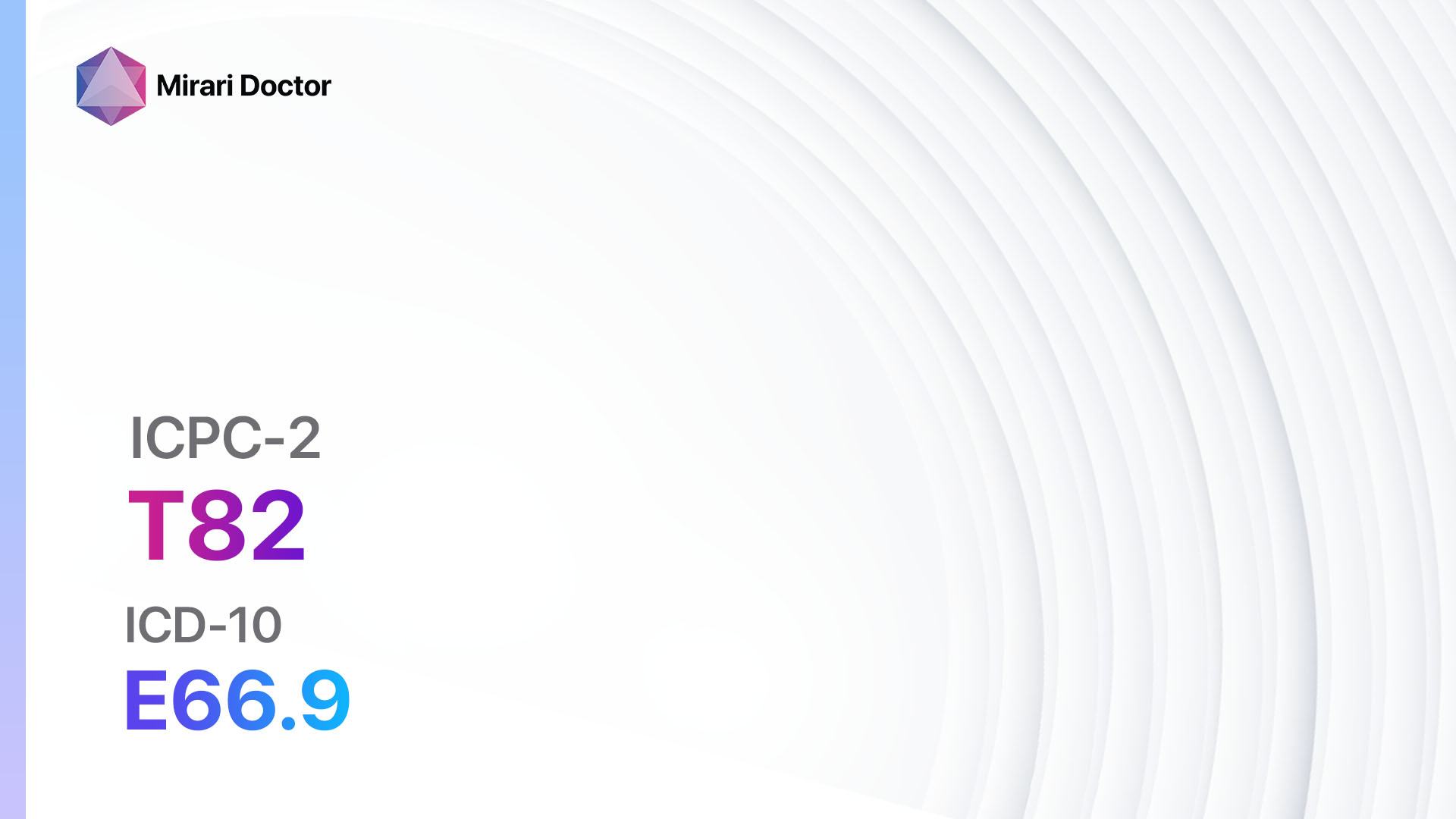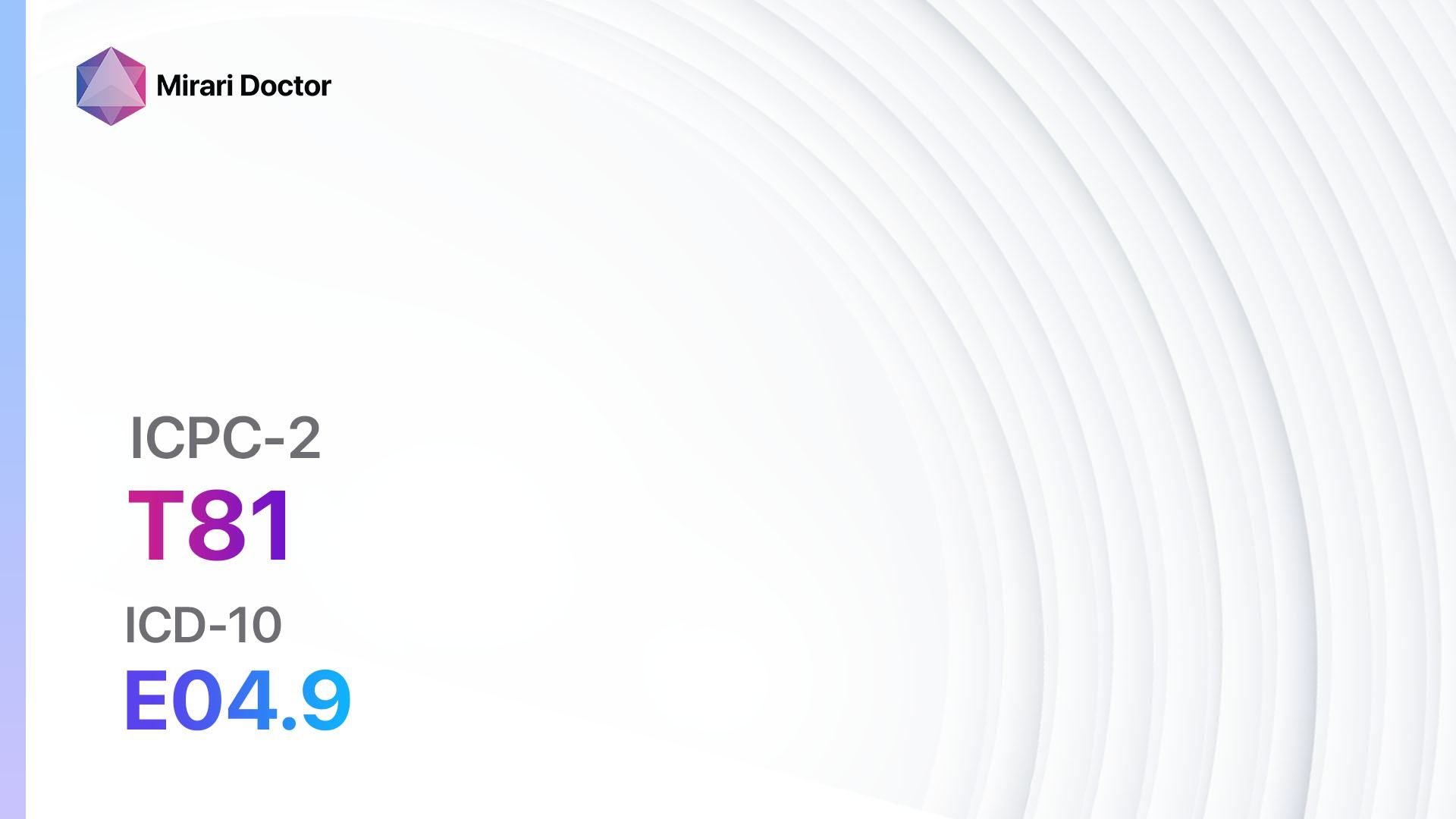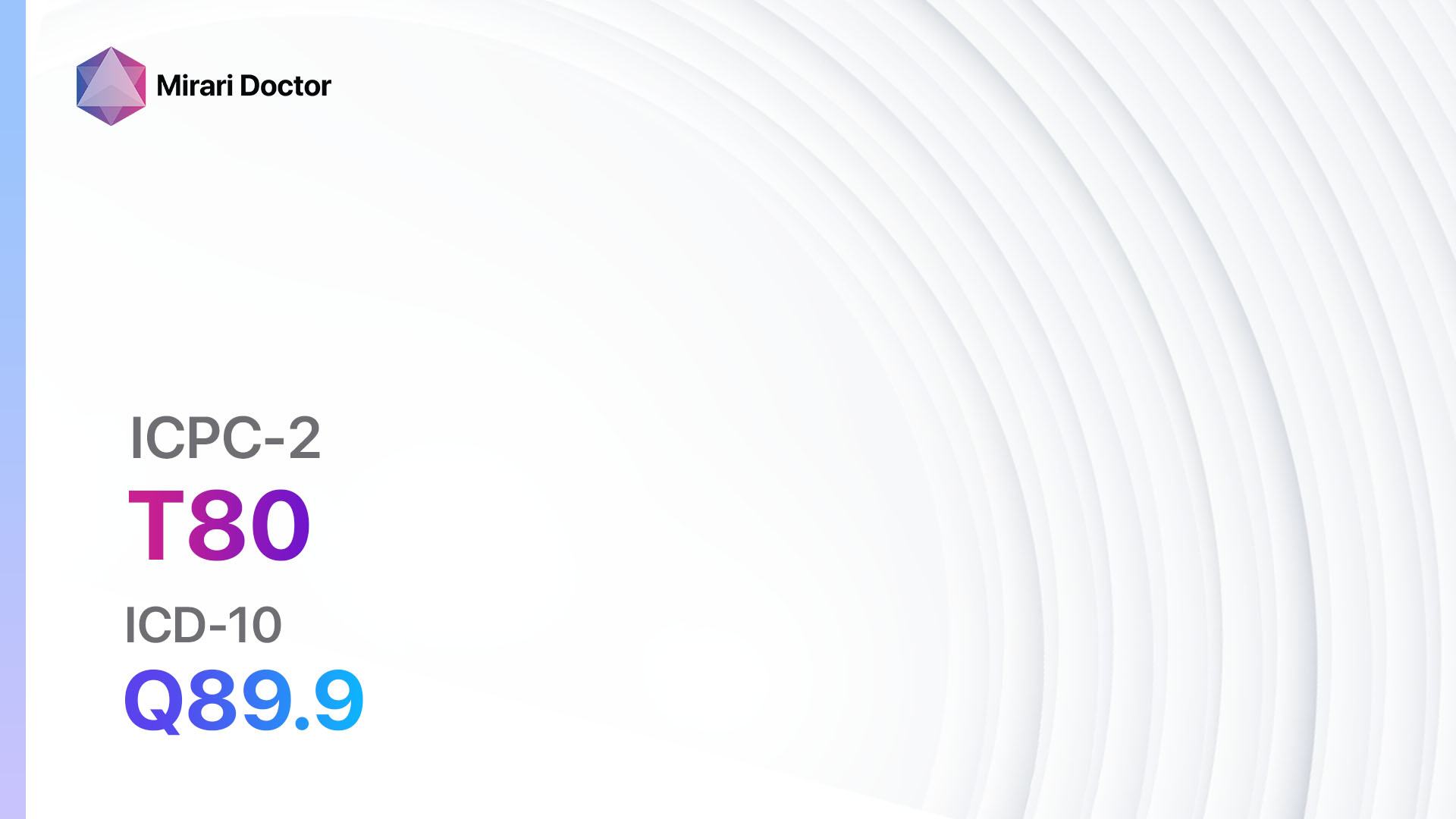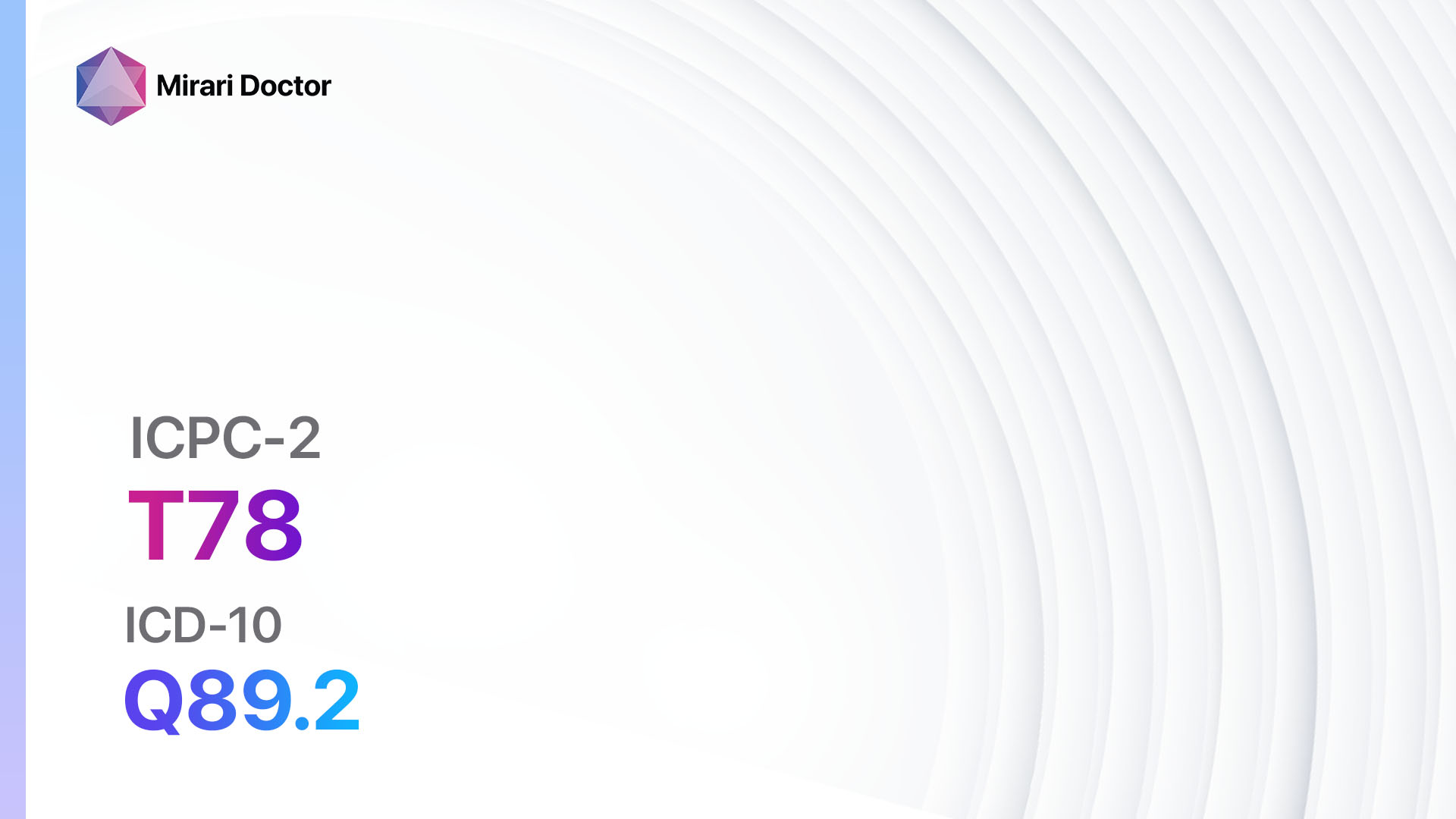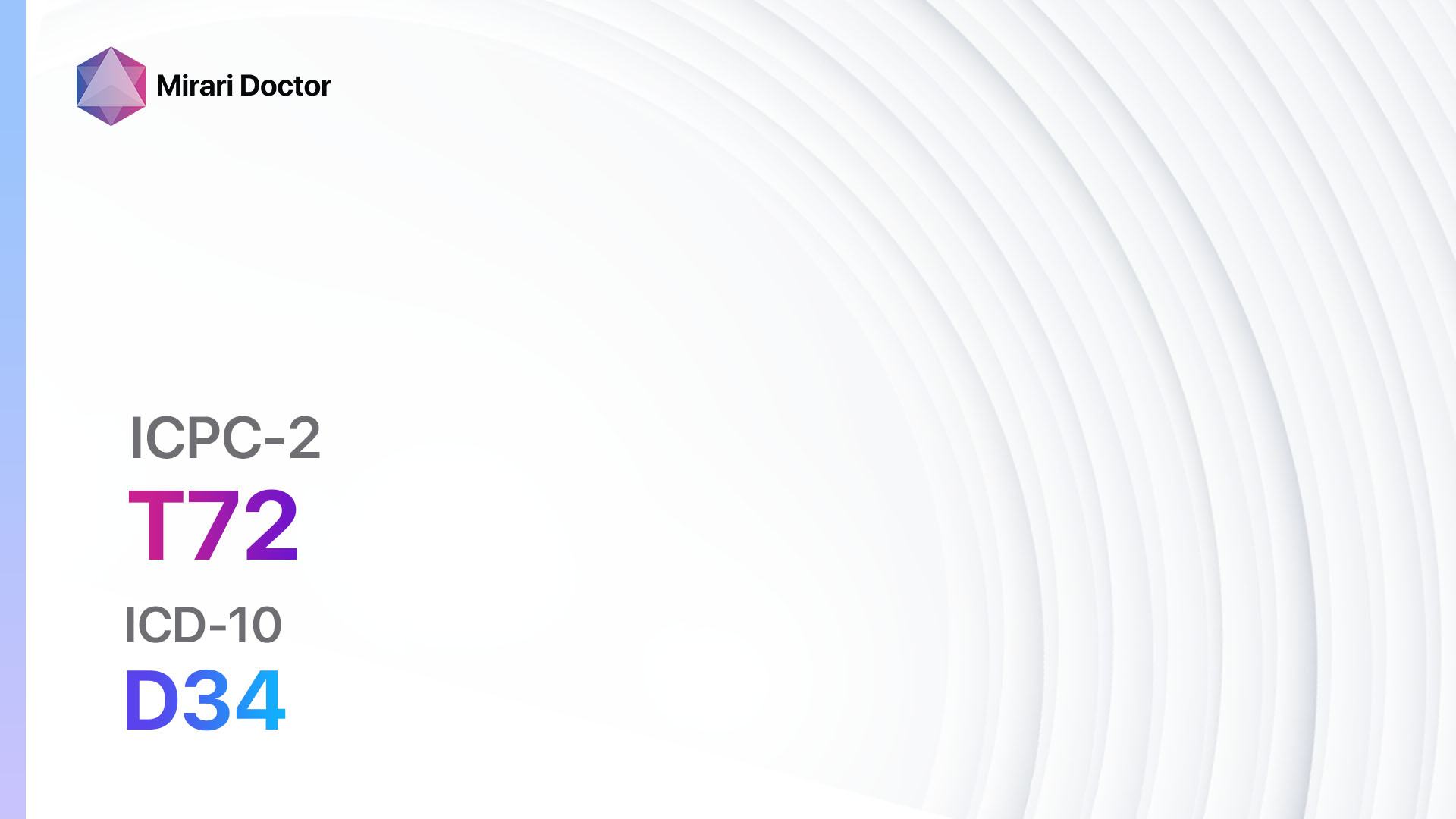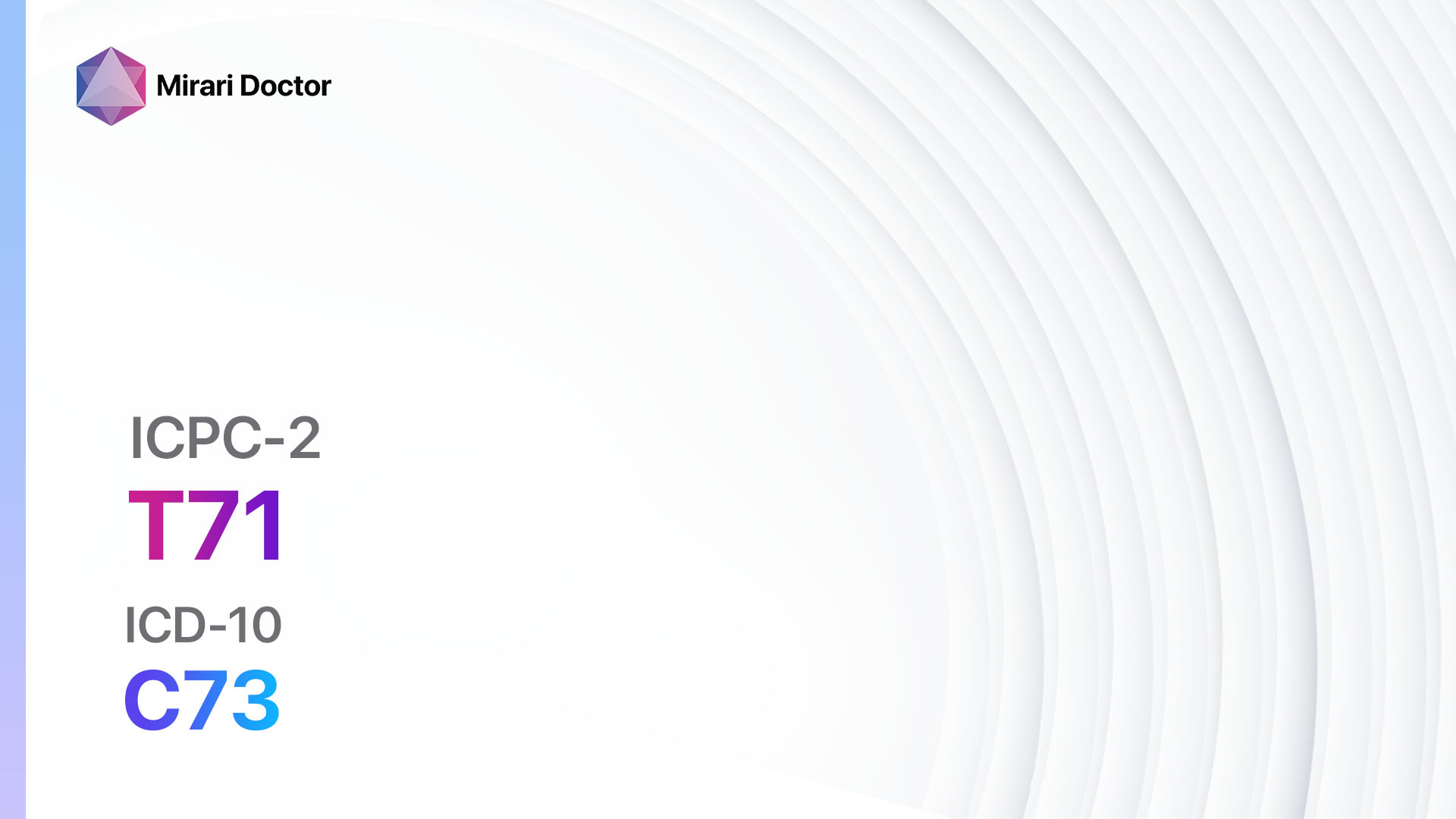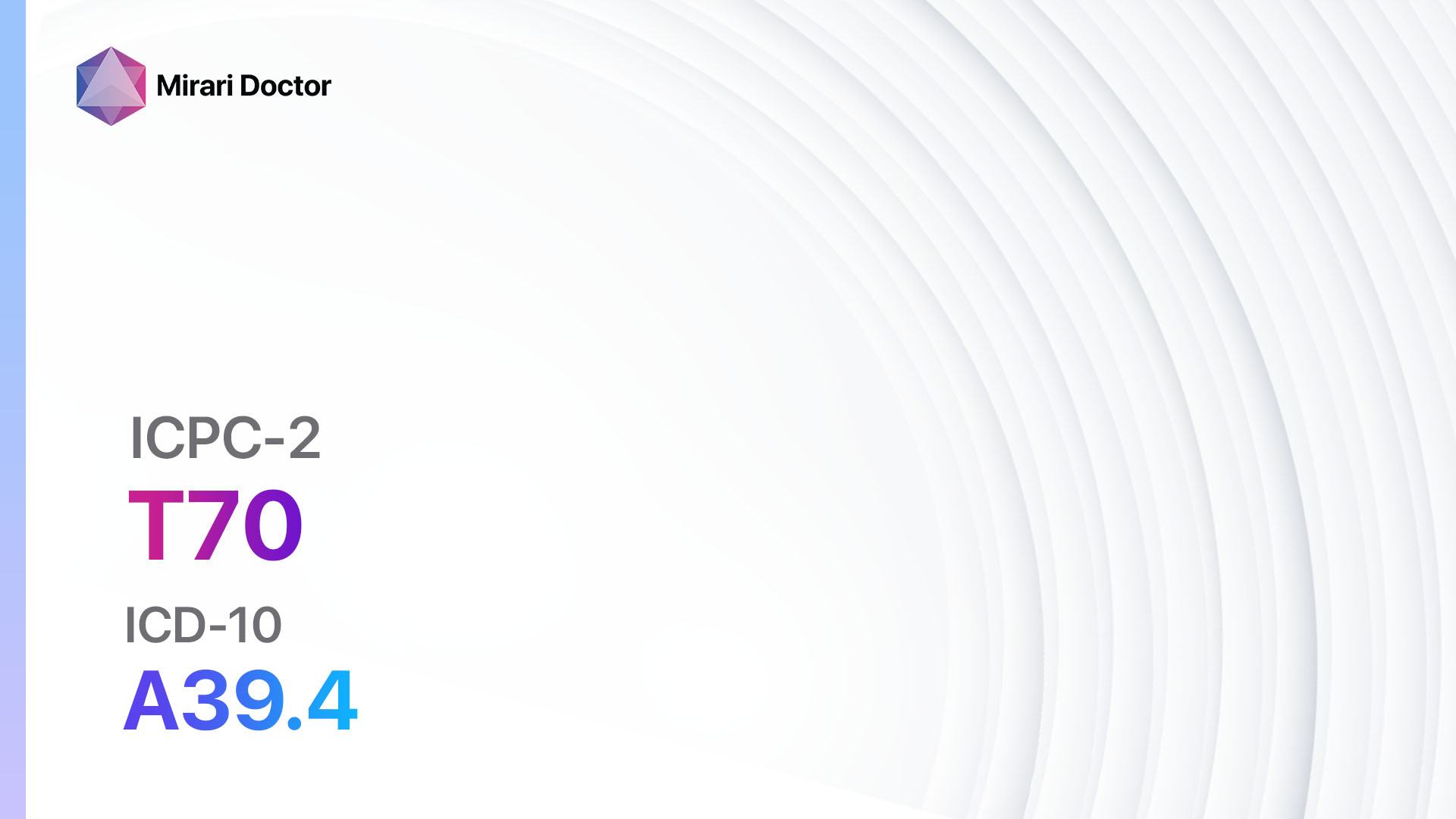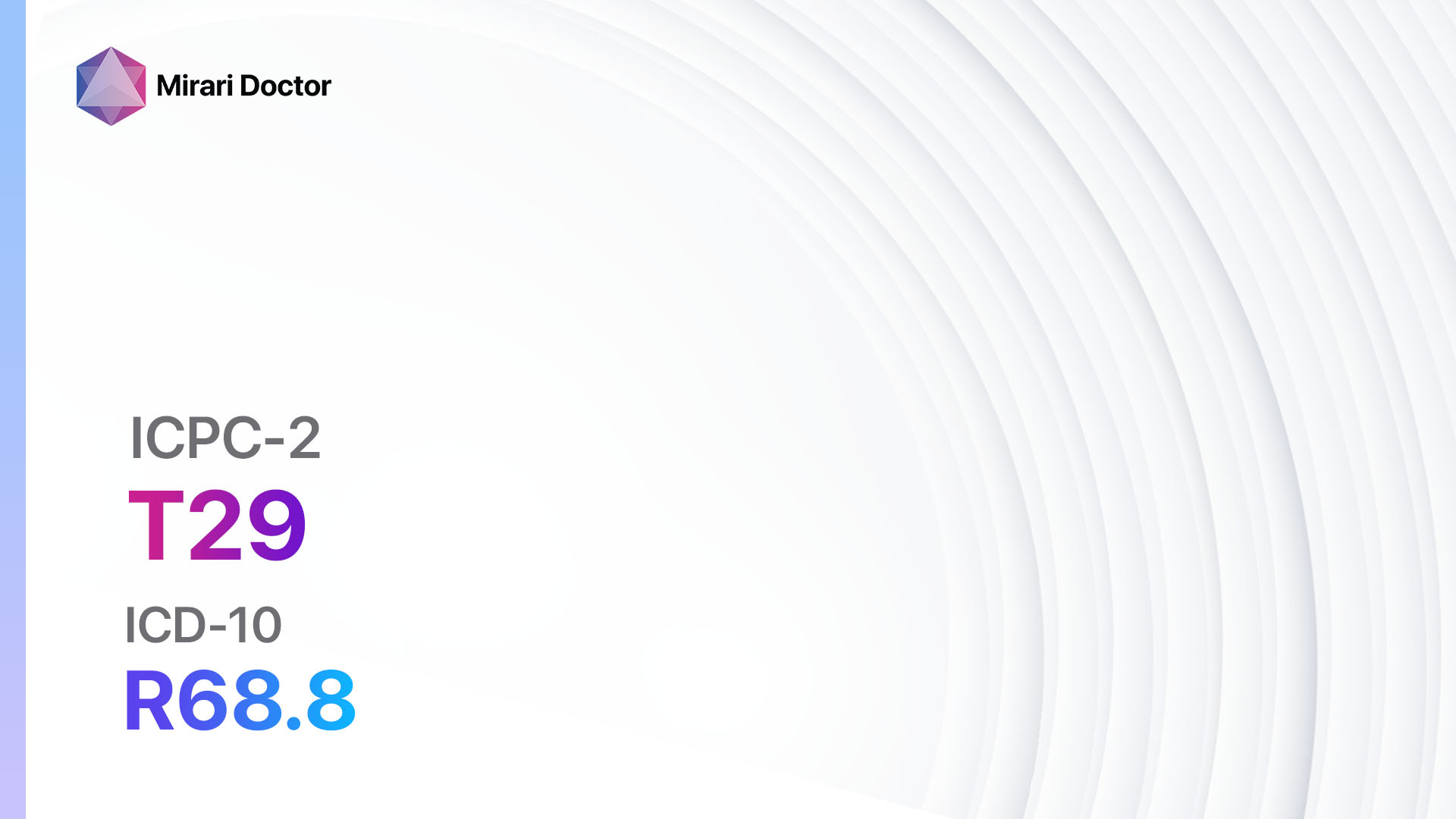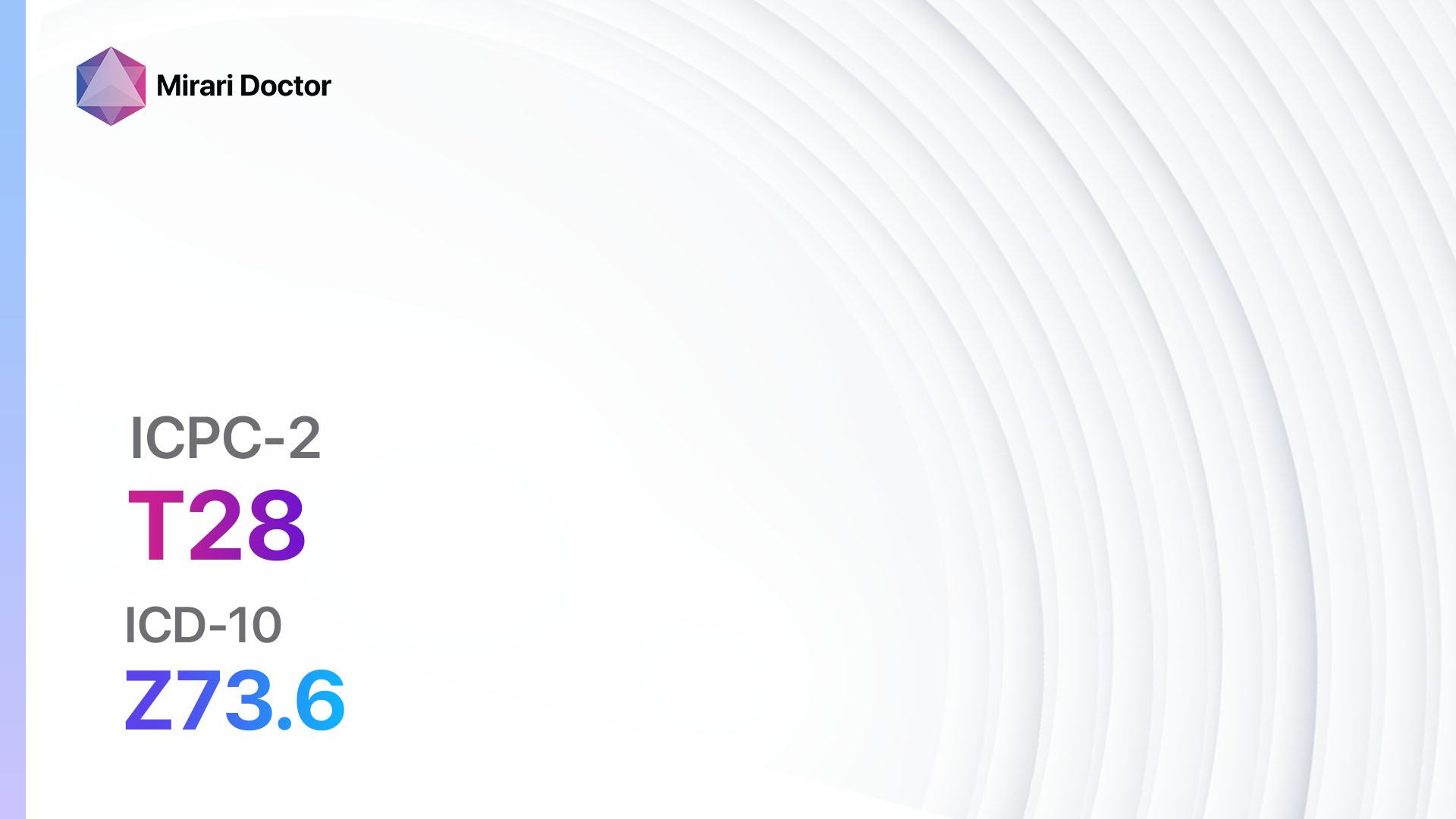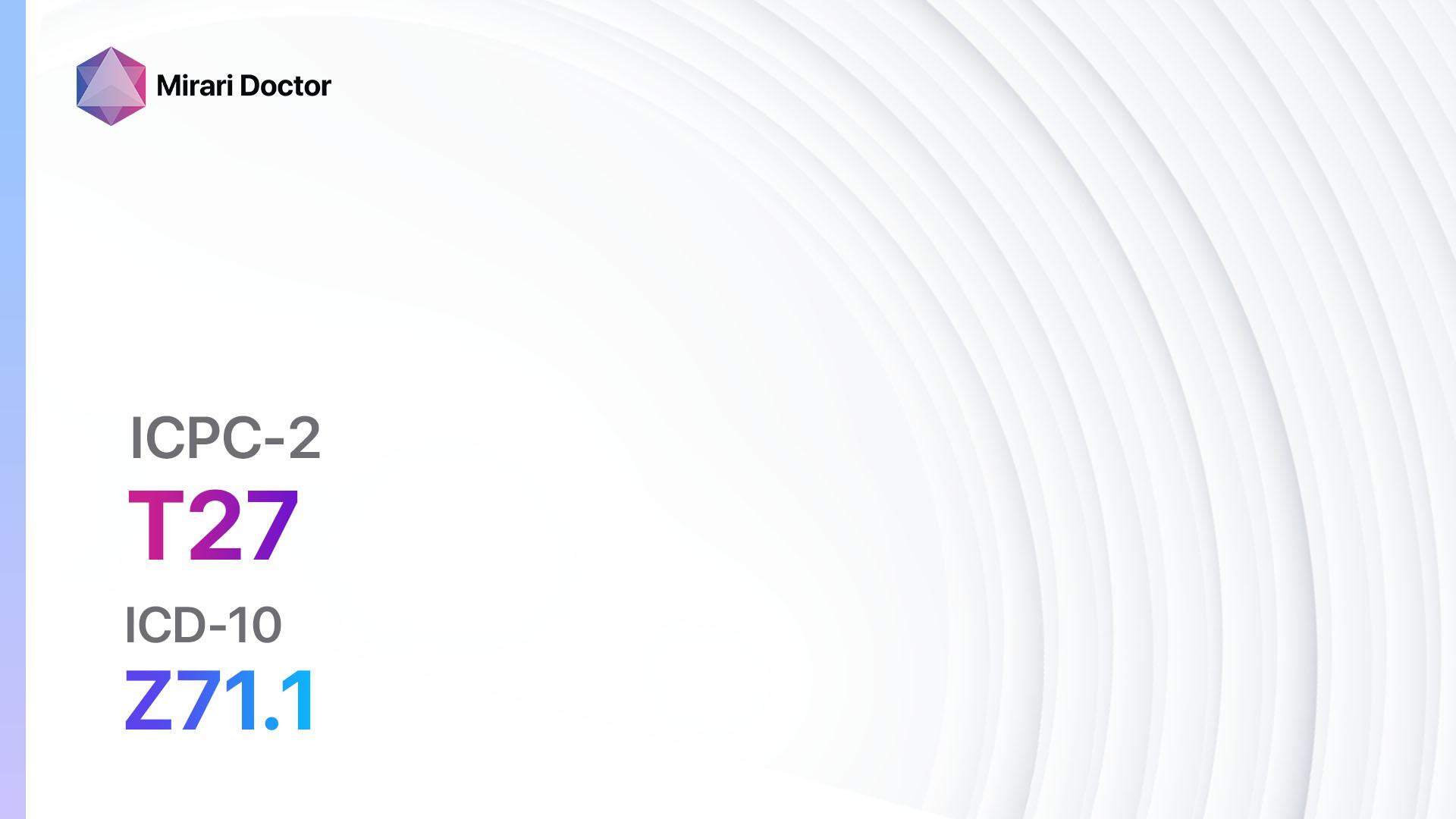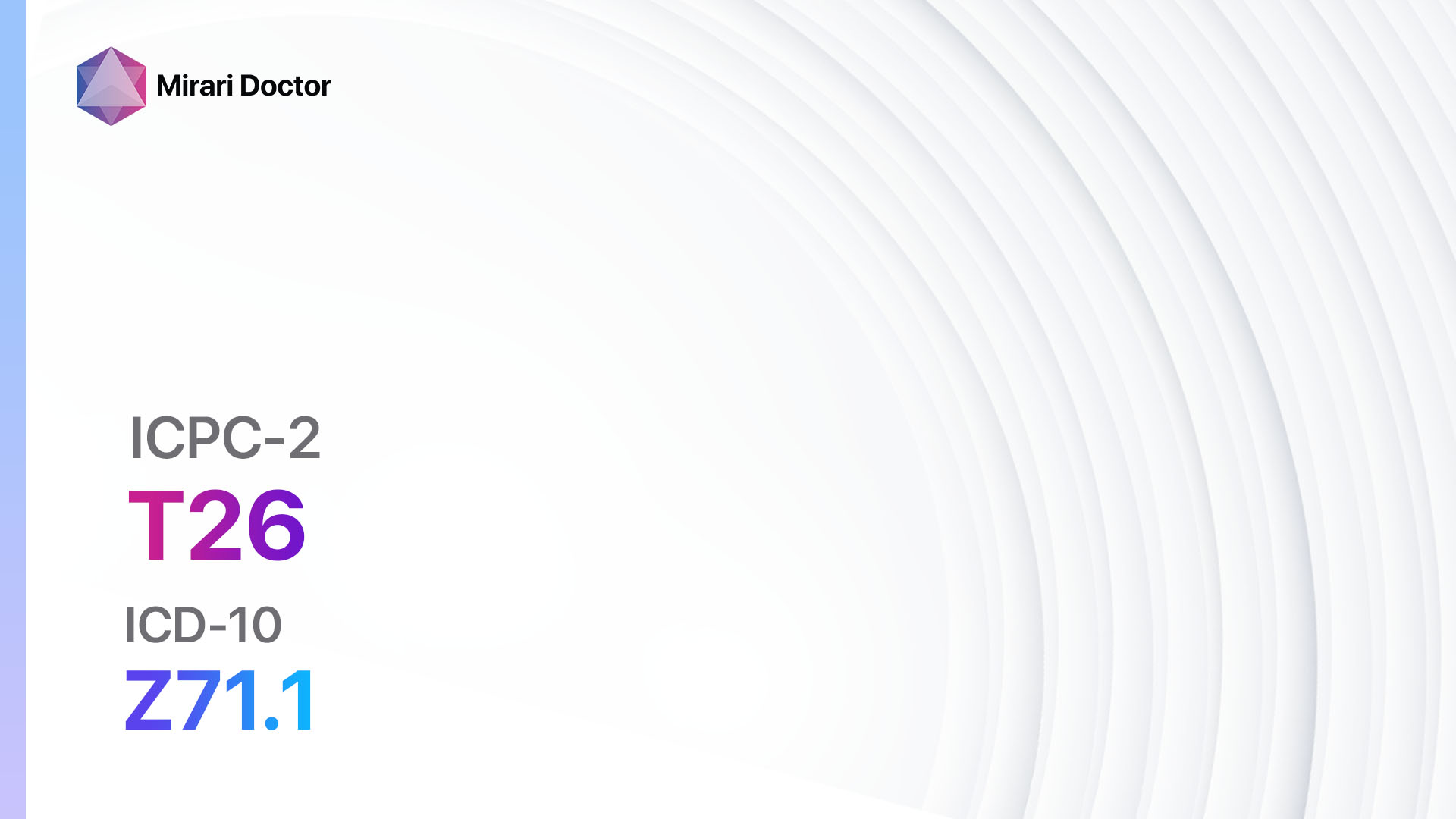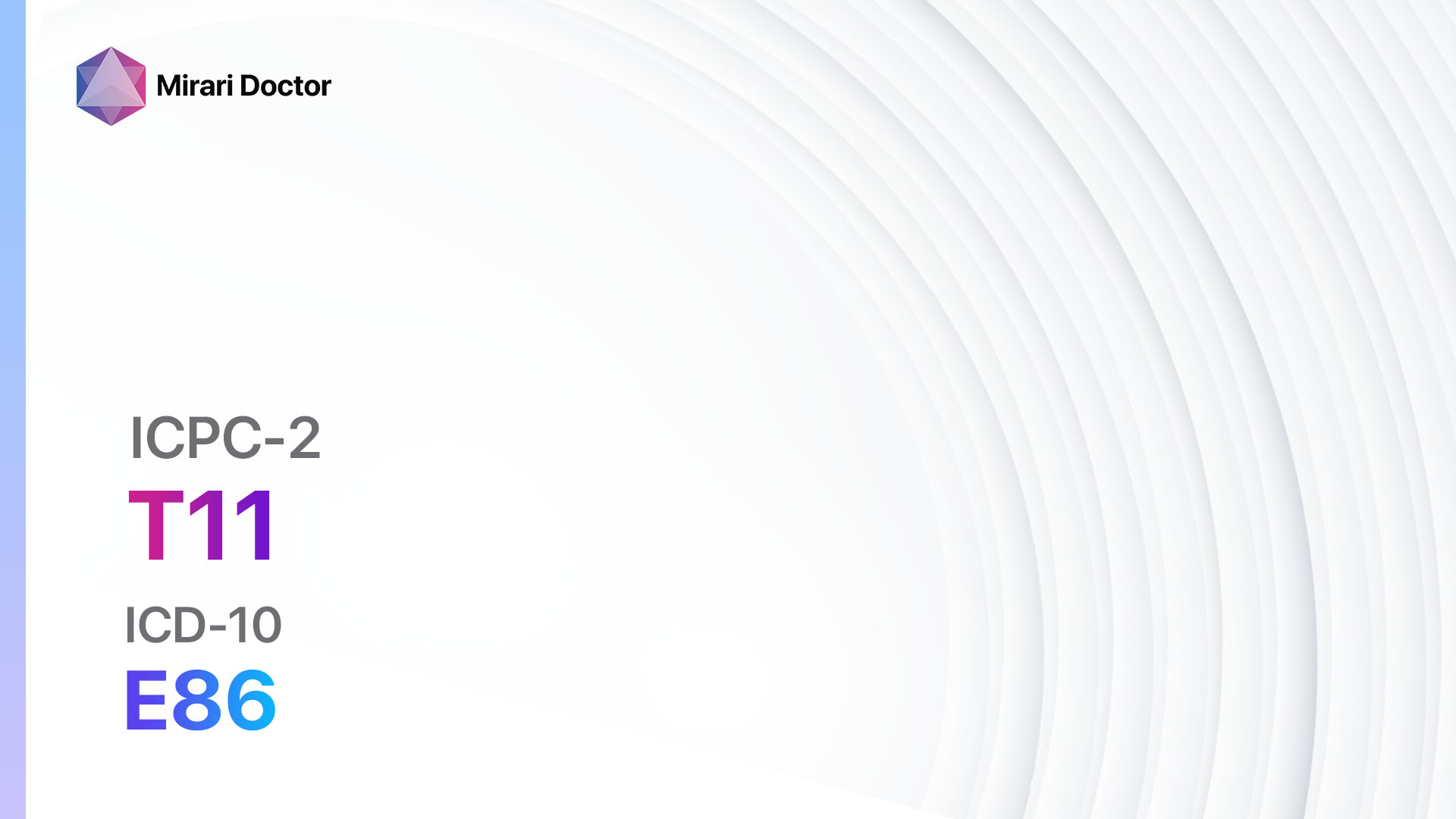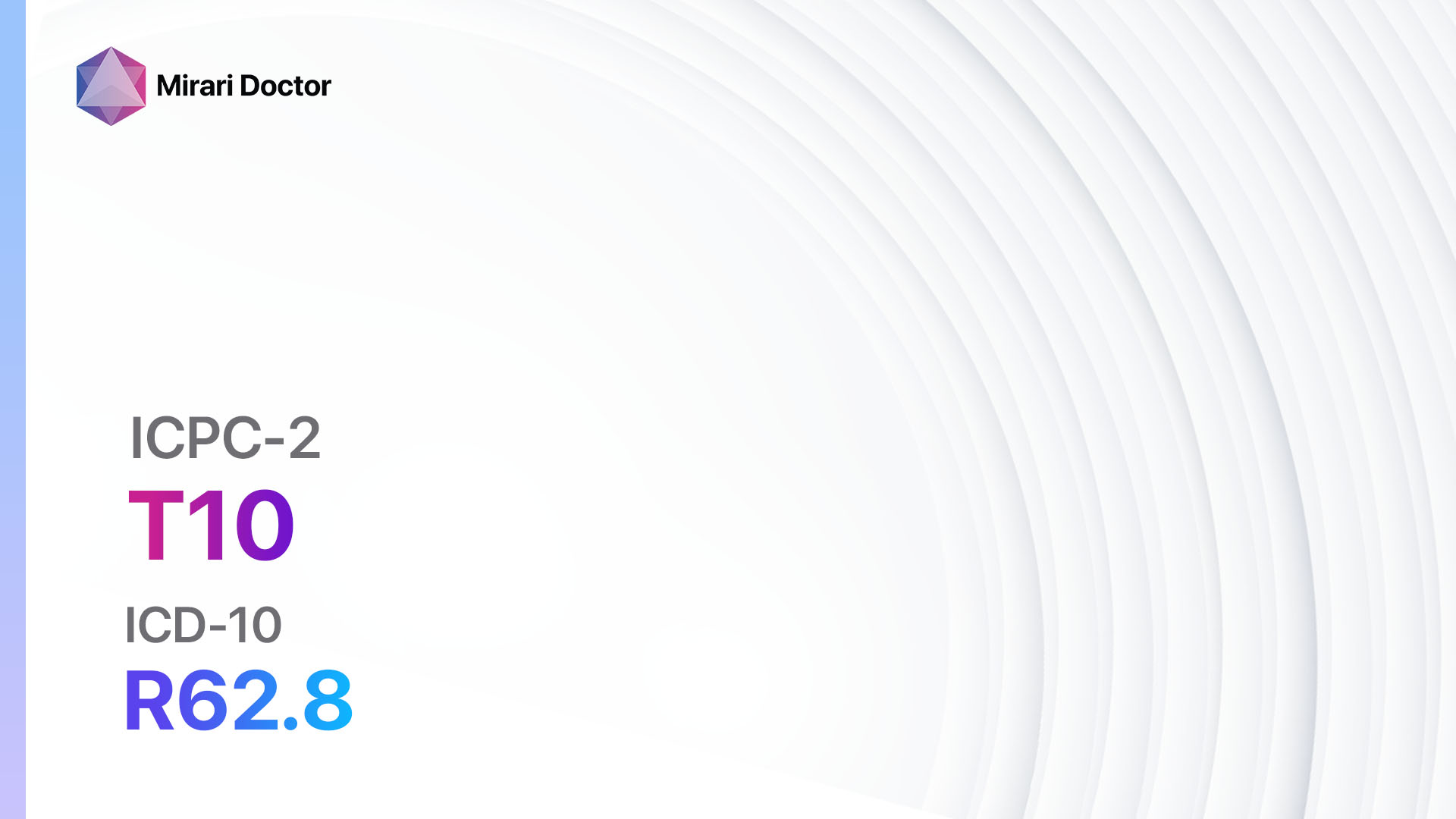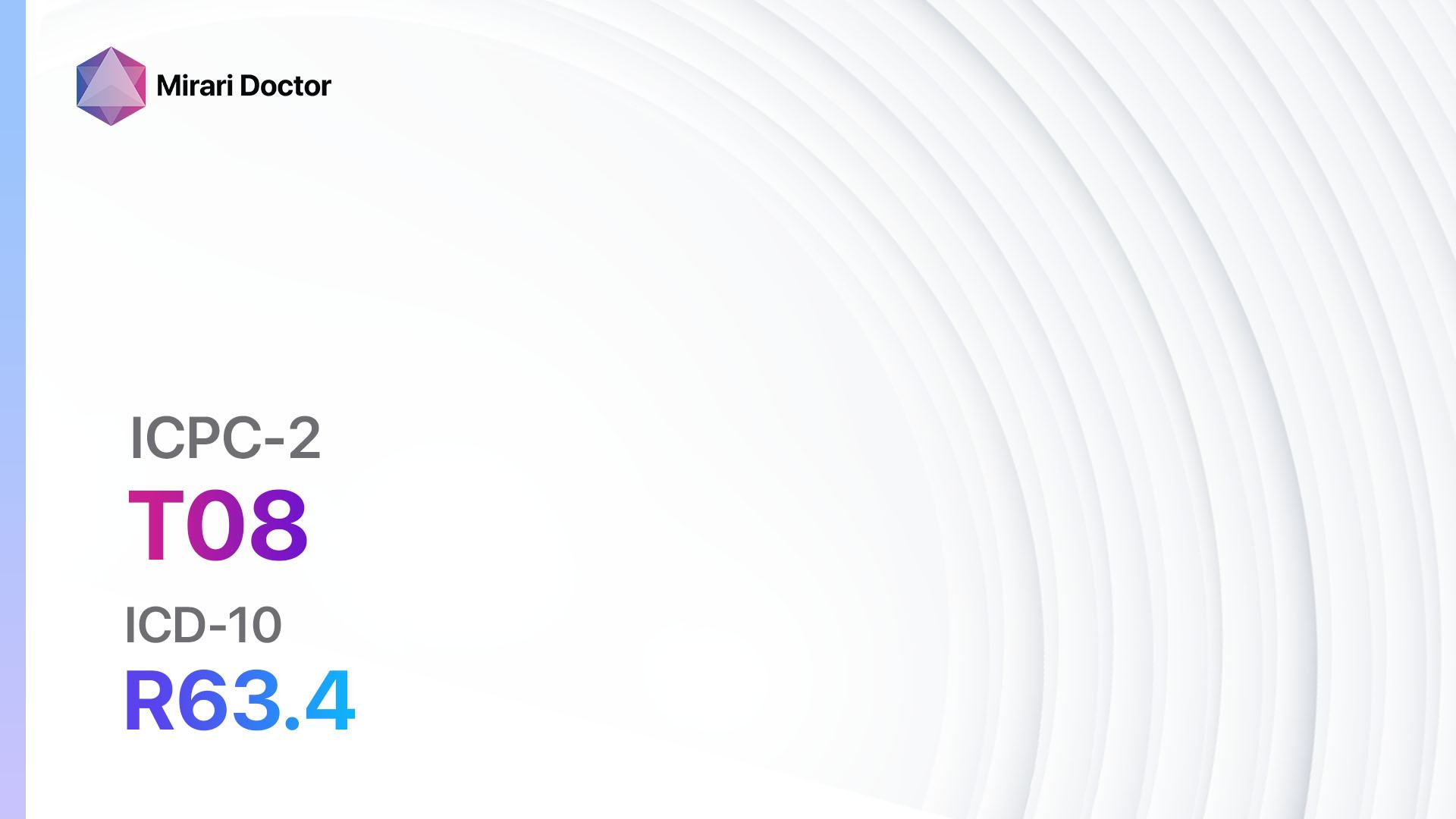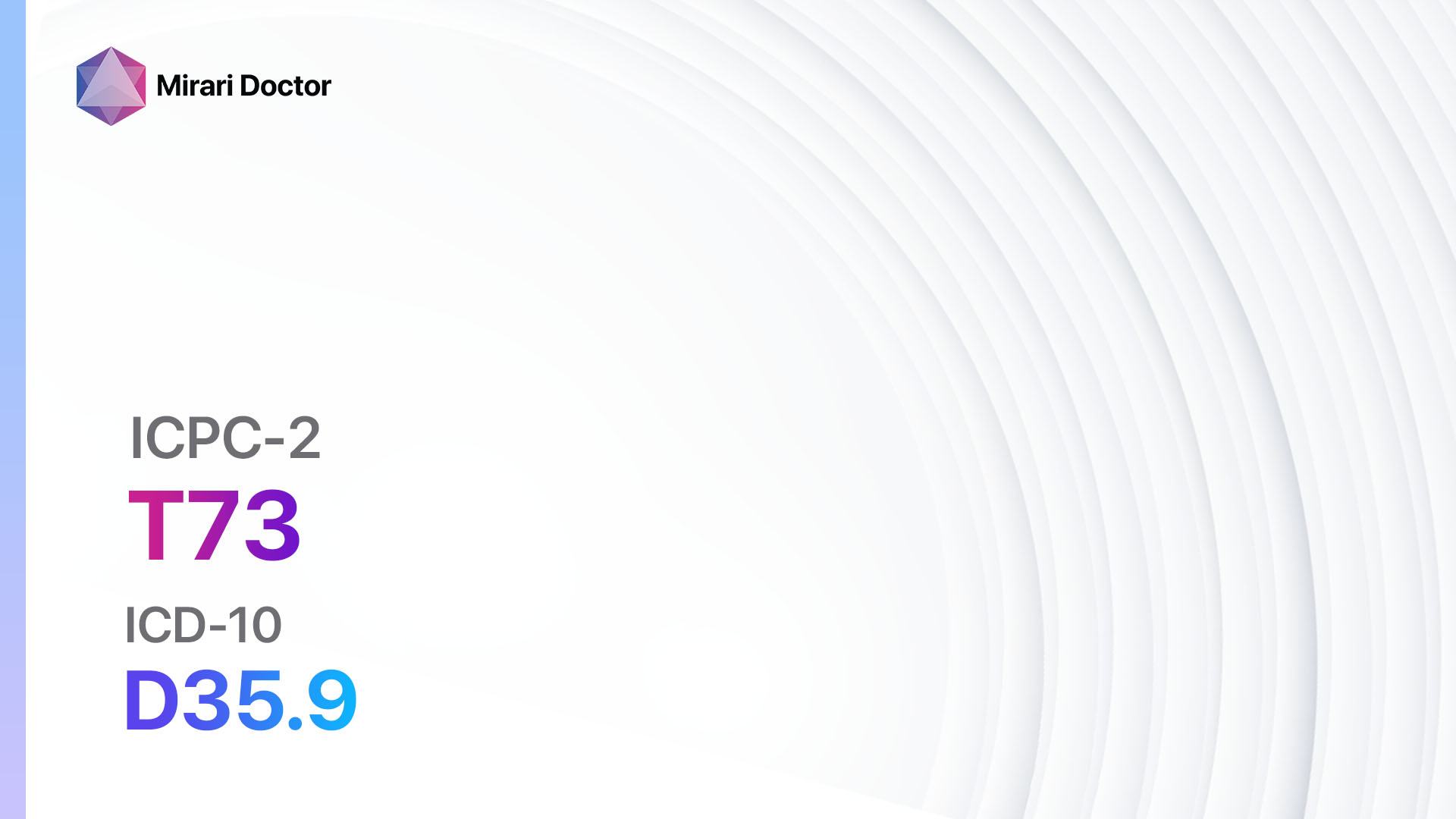
Introduction
Neoplasm endocrine oth/unspecified refers to a type of tumor that arises from the endocrine system, which is responsible for producing hormones. This guide aims to provide a comprehensive overview of the diagnosis and possible interventions for this condition[1].
Codes
- ICPC-2 Code: T73 Neoplasm endocrine oth/unspecified
- ICD-10 Code: D35.9 Benign neoplasm of endocrine gland, unspecified[2]
Symptoms
- Fatigue: Patients may experience persistent tiredness and lack of energy[3].
- Weight changes: Unexplained weight loss or gain may occur[4].
- Hormonal imbalances: Symptoms such as excessive sweating, changes in appetite, and mood swings may be present[5].
- Abdominal pain: Patients may experience pain or discomfort in the abdominal area[6].
- Changes in bowel habits: Bowel movements may become irregular or accompanied by blood[7].
- Palpable mass: A lump or mass may be felt in the affected area[8].
Causes
- Genetic factors: Certain genetic mutations may increase the risk of developing endocrine tumors[9].
- Hormonal imbalances: Imbalances in hormone levels can contribute to the development of neoplasms[10].
- Environmental factors: Exposure to certain chemicals or toxins may increase the risk[1].
Diagnostic Steps
Medical History
- Gather information about the patient’s symptoms, including their duration and severity.
- Identify any risk factors, such as family history of endocrine tumors or exposure to environmental toxins.
- Assess the patient’s medical history, including any previous diagnoses or treatments[3].
Physical Examination
- Perform a thorough physical examination, focusing on the affected area.
- Palpate the abdomen to check for any masses or abnormalities.
- Assess vital signs, including blood pressure and heart rate[5].
Laboratory Tests
- Blood tests: Measure hormone levels, including cortisol, insulin, and thyroid hormones[4].
- Tumor markers: Specific blood tests may be done to detect markers associated with endocrine tumors[6].
- Genetic testing: In some cases, genetic testing may be recommended to identify specific mutations[9].
Diagnostic Imaging
- Ultrasound: Used to visualize the affected area and identify any abnormalities[7].
- CT scan: Provides detailed images of the internal structures and can help determine the size and location of the tumor[8].
- MRI: Offers a more detailed view of the affected area, particularly for tumors in the brain or spinal cord[10].
Other Tests
- Biopsy: A sample of the tumor may be taken for further analysis to confirm the diagnosis[3].
- Nuclear medicine scans: These specialized imaging tests use radioactive substances to detect and locate tumors[6].
Follow-up and Patient Education
- Schedule regular follow-up appointments to monitor the progression of the tumor and assess treatment effectiveness.
- Provide education to the patient about their condition, including potential treatment options and lifestyle modifications[5].
Possible Interventions
Traditional Interventions
Medications:
Top 5 drugs for Neoplasm endocrine oth/unspecified:
- Somatostatin analogs (e.g., Octreotide, Lanreotide):
- Cost: $500-$2,000 per month.
- Contraindications: Hypersensitivity to somatostatin analogs.
- Side effects: Nausea, diarrhea, abdominal pain.
- Severe side effects: Gallstones, liver dysfunction.
- Drug interactions: Cyclosporine, insulin.
- Warning: Regular monitoring of liver function and gallbladder is required.
- Tyrosine kinase inhibitors (e.g., Sunitinib, Vandetanib):
- Cost: $5,000-$10,000 per month.
- Contraindications: Severe liver impairment, pregnancy.
- Side effects: Fatigue, diarrhea, hypertension.
- Severe side effects: Cardiac toxicity, liver failure.
- Drug interactions: CYP3A4 inhibitors, CYP3A4 inducers.
- Warning: Regular monitoring of cardiac function and liver enzymes is required.
- Chemotherapy (e.g., Streptozocin, Doxorubicin):
- Cost: $1,000-$5,000 per cycle.
- Contraindications: Severe bone marrow suppression, pregnancy.
- Side effects: Nausea, vomiting, hair loss.
- Severe side effects: Myelosuppression, cardiotoxicity.
- Drug interactions: Cisplatin, cyclophosphamide.
- Warning: Regular monitoring of blood counts and cardiac function is required.
- Radiopharmaceuticals (e.g., Lutetium-177 DOTATATE, Iodine-131 MIBG):
- Cost: $10,000-$20,000 per treatment.
- Contraindications: Pregnancy, severe renal impairment.
- Side effects: Nausea, vomiting, bone marrow suppression.
- Severe side effects: Renal toxicity, myelosuppression.
- Drug interactions: None reported.
- Warning: Radiation safety precautions should be followed.
- Immunotherapy (e.g., Pembrolizumab, Nivolumab):
- Cost: $10,000-$15,000 per month.
- Contraindications: Severe autoimmune disease, pregnancy.
- Side effects: Fatigue, rash, diarrhea.
- Severe side effects: Immune-related adverse events, pneumonitis.
- Drug interactions: None reported.
- Warning: Regular monitoring of immune function and organ toxicity is required.
Alternative Drugs:
- Interferon-alpha: Can be used as an alternative to somatostatin analogs.
- Everolimus: A targeted therapy that inhibits the mTOR pathway.
- Peptide receptor radionuclide therapy (PRRT): A targeted therapy that delivers radiation directly to tumor cells.
- Cabozantinib: A tyrosine kinase inhibitor used for advanced medullary thyroid cancer.
- Axitinib: Another tyrosine kinase inhibitor used for advanced thyroid cancer.
Surgical Procedures:
- Tumor resection: Surgical removal of the tumor.
- Cost: $10,000-$50,000.
- Contraindications: Inoperable tumors, extensive metastasis.
- Side effects: Pain, infection, bleeding.
- Severe side effects: Organ damage, nerve injury.
- Drug interactions: None reported.
- Warning: Regular follow-up is required to monitor for recurrence.
- Radiofrequency ablation: Uses heat to destroy the tumor.
- Cost: $5,000-$10,000.
- Contraindications: Tumors close to vital structures, extensive metastasis.
- Side effects: Pain, infection, bleeding.
- Severe side effects: Organ damage, nerve injury.
- Drug interactions: None reported.
- Warning: Regular follow-up is required to monitor for recurrence.
- Embolization: Blocks the blood supply to the tumor.
- Cost: $5,000-$10,000.
- Contraindications: Tumors close to vital structures, extensive metastasis.
- Side effects: Pain, infection, bleeding.
- Severe side effects: Organ damage, nerve injury.
- Drug interactions: None reported.
- Warning: Regular follow-up is required to monitor for recurrence.
Alternative Interventions
- Acupuncture: May help alleviate symptoms and improve overall well-being.
- Cost: $60-$120 per session.
- Herbal supplements: Certain herbs, such as ashwagandha and turmeric, may have anti-inflammatory and antioxidant properties.
- Cost: Varies depending on the specific supplement.
- Mind-body techniques: Practices such as meditation and yoga can help reduce stress and improve quality of life.
- Cost: Varies depending on the specific program or class.
- Dietary modifications: A healthy diet rich in fruits, vegetables, and whole grains can support overall health and well-being.
- Cost: Varies depending on individual food choices.
- Exercise: Regular physical activity can improve energy levels and overall fitness.
- Cost: Varies depending on individual preferences and access to exercise facilities.
Lifestyle Interventions
- Stress management: Engaging in stress-reducing activities, such as mindfulness or relaxation techniques, can improve overall well-being.
- Cost: Varies depending on the specific program or activity.
- Smoking cessation: Quitting smoking can improve overall health and reduce the risk of complications.
- Cost: Varies depending on the chosen smoking cessation method.
- Weight management: Maintaining a healthy weight through a balanced diet and regular exercise can support overall health.
- Cost: Varies depending on individual food choices and access to exercise facilities.
- Sleep hygiene: Establishing good sleep habits can improve energy levels and overall well-being.
- Cost: Varies depending on individual preferences and access to sleep aids or therapies.
- Support groups: Joining a support group can provide emotional support and a sense of community.
- Cost: Varies depending on the specific group or organization.
It is important to note that the cost ranges provided are approximate and may vary depending on the location and availability of the interventions.
Mirari Cold Plasma Alternative Intervention
Understanding Mirari Cold Plasma
- Safe and Non-Invasive Treatment: Mirari Cold Plasma is a safe and non-invasive treatment option for various skin conditions. It does not require incisions, minimizing the risk of scarring, bleeding, or tissue damage.
- Efficient Extraction of Foreign Bodies: Mirari Cold Plasma facilitates the removal of foreign bodies from the skin by degrading and dissociating organic matter, allowing easier access and extraction.
- Pain Reduction and Comfort: Mirari Cold Plasma has a local analgesic effect, providing pain relief during the treatment, making it more comfortable for the patient.
- Reduced Risk of Infection: Mirari Cold Plasma has antimicrobial properties, effectively killing bacteria and reducing the risk of infection.
- Accelerated Healing and Minimal Scarring: Mirari Cold Plasma stimulates wound healing and tissue regeneration, reducing healing time and minimizing the formation of scars.
Mirari Cold Plasma Prescription
Video instructions for using Mirari Cold Plasma Device – T73 Neoplasm endocrine oth/unspecified (ICD-10:D35.9)
| Mild | Moderate | Severe |
| Mode setting: 1 (Infection) Location: 6 (Throat, Lymphatic & Thyroid) Morning: 15 minutes, Evening: 15 minutes |
Mode setting: 1 (Infection) Location: 6 (Throat, Lymphatic & Thyroid) Morning: 30 minutes, Lunch: 30 minutes, Evening: 30 minutes |
Mode setting: 1 (Infection) Location: 6 (Throat, Lymphatic & Thyroid) Morning: 30 minutes, Lunch: 30 minutes, Evening: 30 minutes |
| Mode setting: 2 (Wound Healing) Location: 6 (Throat, Lymphatic & Thyroid) Morning: 15 minutes, Evening: 15 minutes |
Mode setting: 2 (Wound Healing) Location: 6 (Throat, Lymphatic & Thyroid) Morning: 30 minutes, Lunch: 30 minutes, Evening: 30 minutes |
Mode setting: 2 (Wound Healing) Location: 6 (Throat, Lymphatic & Thyroid) Morning: 30 minutes, Lunch: 30 minutes, Evening: 30 minutes |
| Mode setting: 7 (Immunotherapy) Location: 6 (Throat, Lymphatic & Thyroid) Morning: 15 minutes, Evening: 15 minutes |
Mode setting: 7 (Immunotherapy) Location: 6 (Throat, Lymphatic & Thyroid) Morning: 30 minutes, Lunch: 30 minutes, Evening: 30 minutes |
Mode setting: 7 (Immunotherapy) Location: 6 (Throat, Lymphatic & Thyroid) Morning: 30 minutes, Lunch: 30 minutes, Evening: 30 minutes |
| Mode setting: 7 (Immunotherapy) Location: 1 (Sacrum) Morning: 15 minutes, Evening: 15 minutes |
Mode setting: 7 (Immunotherapy) Location: 1 (Sacrum) Morning: 30 minutes, Lunch: 30 minutes, Evening: 30 minutes |
Mode setting: 7 (Immunotherapy) Location: 1 (Sacrum) Morning: 30 minutes, Lunch: 30 minutes, Evening: 30 minutes |
| Total Morning: 60 minutes approx. $10 USD, Evening: 60 minutes approx. $10 USD |
Total Morning: 120 minutes approx. $20 USD, Lunch: 120 minutes approx. $20 USD, Evening: 120 minutes approx. $20 USD, |
Total Morning: 120 minutes approx. $20 USD, Lunch: 120 minutes approx. $20 USD, Evening: 120 minutes approx. $20 USD, |
| Usual treatment for 7-60 days approx. $140 USD – $1200 USD | Usual treatment for 6-8 weeks approx. $2,520 USD – $3,360 USD |
Usual treatment for 3-6 months approx. $5,400 USD – $10,800 USD
|
 |
|
Use the Mirari Cold Plasma device to treat Neoplasm endocrine oth/unspecified effectively.
WARNING: MIRARI COLD PLASMA IS DESIGNED FOR THE HUMAN BODY WITHOUT ANY ARTIFICIAL OR THIRD PARTY PRODUCTS. USE OF OTHER PRODUCTS IN COMBINATION WITH MIRARI COLD PLASMA MAY CAUSE UNPREDICTABLE EFFECTS, HARM OR INJURY. PLEASE CONSULT A MEDICAL PROFESSIONAL BEFORE COMBINING ANY OTHER PRODUCTS WITH USE OF MIRARI.
Step 1: Cleanse the Skin
- Start by cleaning the affected area of the skin with a gentle cleanser or mild soap and water. Gently pat the area dry with a clean towel.
Step 2: Prepare the Mirari Cold Plasma device
- Ensure that the Mirari Cold Plasma device is fully charged or has fresh batteries as per the manufacturer’s instructions. Make sure the device is clean and in good working condition.
- Switch on the Mirari device using the power button or by following the specific instructions provided with the device.
- Some Mirari devices may have adjustable settings for intensity or treatment duration. Follow the manufacturer’s instructions to select the appropriate settings based on your needs and the recommended guidelines.
Step 3: Apply the Device
- Place the Mirari device in direct contact with the affected area of the skin. Gently glide or hold the device over the skin surface, ensuring even coverage of the area experiencing.
- Slowly move the Mirari device in a circular motion or follow a specific pattern as indicated in the user manual. This helps ensure thorough treatment coverage.
Step 4: Monitor and Assess:
- Keep track of your progress and evaluate the effectiveness of the Mirari device in managing your Neoplasm endocrine oth/unspecified. If you have any concerns or notice any adverse reactions, consult with your health care professional.
Note
This guide is for informational purposes only and should not replace the advice of a medical professional. Always consult with your healthcare provider or a qualified medical professional for personal advice, diagnosis, or treatment. Do not solely rely on the information presented here for decisions about your health. Use of this information is at your own risk. The authors of this guide, nor any associated entities or platforms, are not responsible for any potential adverse effects or outcomes based on the content.
Mirari Cold Plasma System Disclaimer
- Purpose: The Mirari Cold Plasma System is a Class 2 medical device designed for use by trained healthcare professionals. It is registered for use in Thailand and Vietnam. It is not intended for use outside of these locations.
- Informational Use: The content and information provided with the device are for educational and informational purposes only. They are not a substitute for professional medical advice or care.
- Variable Outcomes: While the device is approved for specific uses, individual outcomes can differ. We do not assert or guarantee specific medical outcomes.
- Consultation: Prior to utilizing the device or making decisions based on its content, it is essential to consult with a Certified Mirari Tele-Therapist and your medical healthcare provider regarding specific protocols.
- Liability: By using this device, users are acknowledging and accepting all potential risks. Neither the manufacturer nor the distributor will be held accountable for any adverse reactions, injuries, or damages stemming from its use.
- Geographical Availability: This device has received approval for designated purposes by the Thai and Vietnam FDA. As of now, outside of Thailand and Vietnam, the Mirari Cold Plasma System is not available for purchase or use.
References
- WebMD. Endocrine Disorders: Types, Causes, Symptoms, and Treatments. Retrieved from https://www.webmd.com/diabetes/endocrine-system-disorders
- Gesund.bund.de. C75.9 Malignant neoplasm: Endocrine gland, unspecified. Retrieved from https://gesund.bund.de/en/icd-code-search/c75-9
- Walczyk J, Sowa-Staszczak A. Diagnostic imaging of gastrointestinal neuroendocrine neoplasms with a focus on ultrasound. J Ultrason. 2019;19(79):228-242. doi:10.15557/JoU.2019.0034
- WVU Cancer Institute. Endocrine Tumors. Retrieved from https://cancer.wvumedicine.org/patients-visitors/cancers-we-treat/endocrine-tumors/
- Chiti G, Grazzini G, Cozzi D, et al. Imaging of Pancreatic Neuroendocrine Neoplasms. Diagnostics (Basel). 2021;11(9):1652. doi:10.3390/diagnostics11091652
- PDQ Cancer Genetics Editorial Board. Genetics of Endocrine and Neuroendocrine Neoplasias (PDQ®): Health Professional Version. 2022 May 20. In: PDQ Cancer Information Summaries [Internet]. Bethesda (MD): National Cancer Institute (US); 2002-. Available from: https://www.ncbi.nlm.nih.gov/books/NBK65830/
- Longdom Publishing. Endocrine Neoplasia: Causes, Symptoms, Diagnosis, and Treatment. Retrieved from https://www.longdom.org/open-access-pdfs/endocrine-neoplasia-causes-symptoms-diagnosis-and-treatment.pdf
- Villines Z. Endocrine disorders: Causes, types, and diagnosis. Medical News Today. Retrieved from https://www.medicalnewstoday.com/articles/endocrine-disorders
- Cancer Treatment Centers of America. Neuroendocrine Tumor Diagnosis: Tests, Scans & Biopsies. Retrieved from https://www.cancercenter.com/cancer-types/neuroendocrine-tumors/diagnosis-and-detection
- UCLA Health. Genetic Syndromes – Endocrine Surgery. Retrieved from https://www.uclahealth.org/medical-services/surgery/endocrine-surgery/conditions-treated/genetic-syndromes
Related articles
Made in USA


